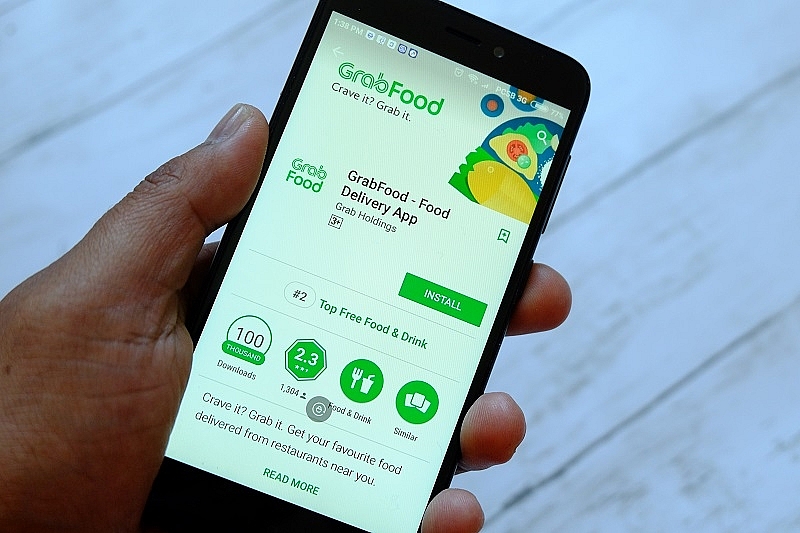Ride-hailers break into food delivery
 |
| GrabFood , photo: shutterstock |
A slew of newcomers
 |
In recent months, ride-hailing firms in Vietnam have been jumping on the food delivery bandwagon, eager to tap into the booming online food ordering market. For example, following the acquisition of UberEats, in May Grab brought out its on-demand food delivery service called GrabFood in Ho Chi Minh City. This marks Grab’s next major step towards becoming an “everyday super app” that encompasses all sorts of services from ride-hailing and cashless payments to food delivery.
At the same time, the Vietnamese subsidiary of Indonesia’s Go-Jek, Go-Viet, is also set to roll out its Go-Food food delivery service, in addition to its car-hailing and mobile wallets. In its home turf Indonesia, Go-Food is already the dominant player in food delivery and the firm hopes to repeat this success in Vietnam.
It is easy to see why Grab and Go-Jek want a slice of the Vietnamese online delivery market. Research provider Euromonitor shows that Vietnam’s online food delivery market is growing exponentially and will be worth $33 billion in 2018. Further, revenues are expected to reach $38 billion by 2020 at a compound annual growth rate of 11 per cent between 2018 and 2020.
Mathilde Tran, senior manager of CEL Consulting, told VIR that online food delivery could possibly enjoy rapid development in Vietnam’s urban areas, among customer groups like office workers, working women, and those with less time to shop, cook, and clean on a daily basis.
“Food delivery brings multiple options to choose from, is available at your door, and customers do not need to clean up after the meals,” said Tran, adding that ride-hailing firms have a competitive edge thanks to their versatile platforms, huge customer databases, and a large number of drivers.
Ashish Kanchan, managing director of Kantar TNS, pointed out that the food habits of Vietnamese people are changing rapidly due to a busier lifestyle, urbanisation, and internet connectivity. “Ordering food online is the new norm,” said Kanchan.
For Vietnamese restaurants, making deals with food delivery platforms is a no-brainer, as they no longer have to limit their revenues by seating capacity. They can also rely on the logistics network of the food delivery platforms, as well as promote their business to a huge platform of consumers.
Upon entering Vietnam, GrabFood and Go-Food will have to compete against existing players that focus on food delivery. The two biggest names are Foody’s Now and Takeaway’s Vietnammm. Now, formerly Delivery Now, operates through both website and mobile app platforms. According to founder Dang Ngoc Minh, Now is the main income source of Foody, the eatery review startup.
Meanwhile, Vietnammm has partnered up with more than 2,000 restaurants across the country and grew its business after buying out Foodpanda in 2015. Other players include VCCorp’s eat.vn and chonmon.vn as well as Lala by Ho Chi Minh City-based Scommerce Group.
Not an easy ride
With all the flurry of excitement, it may seem that food delivery services in Vietnam are a sure thing. However, the reality is that all of them are in for a tough game, and success is by no means guaranteed.
It may be useful to look back at the ill-fated Foodpanda, which sold its Vietnam-based business to domestic rival Vietnammm in late 2015. Despite its popularity in 40 markets worldwide, Foodpanda encountered financial problems during its three-year run in Vietnam and failed to compete against Vietnammm and Eat.vn. The firm admitted upon quitting that it chose to focus on more developed markets. At the time, Vietnam was better suited for competitors with a longer-term vision.
Elsewhere in the region, players are also feeling the heat. Sprig in India ceased business in late 2017, right after raising $56.7 million from investors. Last month, Singapore’s Fastbee, which delivers food via vending machines, also ran out of cash and stopped operations immediately.
According to a sector report by market researcher McKinsey and Company, the biggest challenge for food delivery firms is speed. Consumers want their food hot and delivered to their doorsteps within 60 minutes, which means food delivery firms must race against time and the busy traffic.
Tran from CEL Consulting added that as drivers can pick up food from a number of restaurants along the way, the combined route and time restraints can be challenging.
“Moreover, drivers must be equipped with thermal bags and conveyance. The food must always be kept warm and fresh,” said Tran.
In fact, most experts agree that hygienic standards can make or break a food delivery firm, as in the case of China’s Meituan. In the past year, Meituan has fired two deliverymen for messing with the customers’ food and amid public outrage promised to launch sealed boxes to prevent any tampering.
Ride-hailing apps, despite their superior logistics skills and vast customer base, are not yet experts in food hygiene and handling.
Kanchan from Kantar TNS told VIR that a major task for ride-hailing services is to work with restaurants to ensure top-notch food safety.
“In mature markets, there are growing concerns of food safety and working with restaurants and kitchens, who may list their menus on their apps without appropriate food preparation and hygiene licences,” said Kanchan.
Last but not least, as is the case with e-commerce sites and startups in general, profitability seems to take the backseat for food delivery firms. In a race to increase their market share and attract new users, the apps are offering huge promotions and are burning investors’ money. According to analysts, investors will have to patiently wait before they can reap any profit from these food delivery firms.
Recipe for success
Experts like Kantar TNS believe that to come out on top, food delivery services in Vietnam must secure strong backing from investors and use the capital wisely.
In a recent report, the research department at Siam Commercial Bank (Thailand) pointed out that the prudent use of money and localisation are key. “As seen in the failure of Foodpanda in Vietnam, it is clear that local market knowledge and understanding are at the forefront. It is vital that food operators understand customers’ priorities in each market. The failure of Uber and Uber Eats in the ASEAN is partly attributable to Uber’s lack of localisation efforts,” said Siam Commercial Bank.
The researchers at Siam Commercial Bank added that the line between food and non-food delivery will be blurred as startups will attempt to include both services. Differentiation can be done by providing a unique service or choosing a niche market, meeting sophisticated demands from consumers.
Some startups, such as Grain in Singapore or Dahmakan in Malaysia, chose to build their own kitchen and control the entire supply chain. Others allow consumers to place multiple orders at different restaurants, similar to what Honestbee (Singapore) does. An app in China called Home-Cook went even further into the sharing economy and enables sharing home-cooked meals.
However, most importantly, Tran said that to retain customers, food delivery apps must ensure good promotions, food safety, and fast delivery time, in addition to building a vast network of food providers.
What the stars mean:
★ Poor ★ ★ Promising ★★★ Good ★★★★ Very good ★★★★★ Exceptional
Related Contents
Latest News
More News
- PM orders investment model for North–South high-speed rail (December 22, 2025 | 17:43)
- First members of Danang International Finance Centre revealed (December 22, 2025 | 17:39)
- Securing capital and efficiency for Vietnam’s 2026-2030 growth ambitions (December 17, 2025 | 10:00)
- Driving double-digit growth through green and circular transformation in Vietnam (December 17, 2025 | 09:00)
- Vietnam bucking trend in the global M&A landscape (December 16, 2025 | 14:20)
- Vietnam’s green transition demands collective financial action (December 15, 2025 | 12:00)
- VIR workshop highlights capital and policy for sustainable development (December 15, 2025 | 11:00)
- National Assembly approves pilot mechanisms to accelerate major projects in Hanoi (December 12, 2025 | 11:29)
- Vietnam eases policy approval requirements, simplifies foreign and outbound investments (December 11, 2025 | 17:53)
- Unpacking new momentum in Vietnam’s M&A market (December 10, 2025 | 09:59)

 Tag:
Tag:





















 Mobile Version
Mobile Version